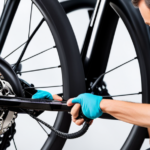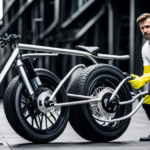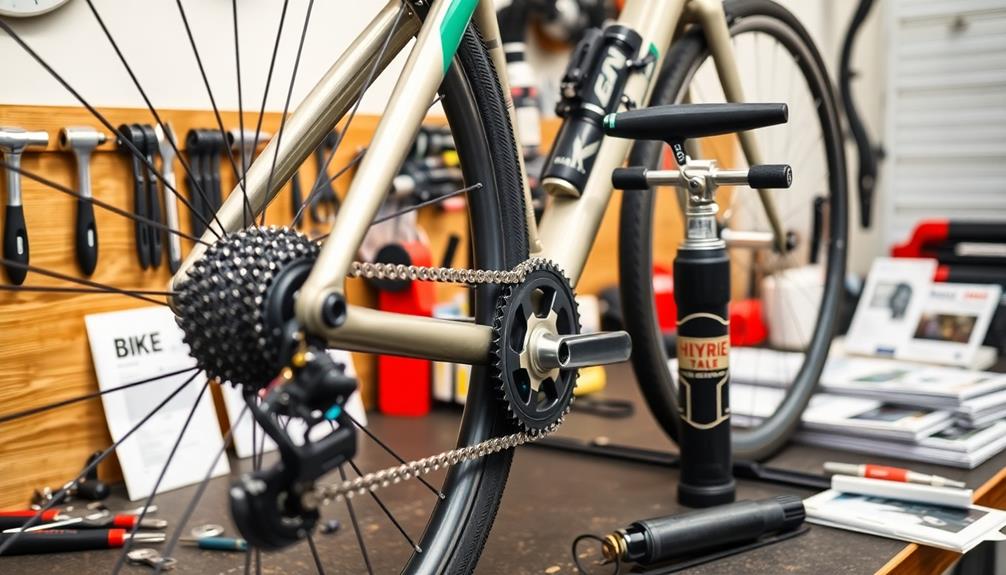After a rainy ride, start by gently rinsing your bike to remove mud and grime, paying special attention to the chain, drivetrain, and brake areas. Wipe down the frame and components with a soft cloth, then dry everything thoroughly using towels, especially in moisture-trapping spots. Protect your bike with a moisture dispersant and inspect your electrical contacts and battery, making sure they’re dry before reattaching. For full details on proper care, keep exploring for expert tips to keep your bike in top shape.
Key Takeaways
- Rinse the bike gently with water, focusing on removing mud, grime, and water from drivetrain and hard-to-reach areas.
- Dry all components thoroughly using towels or microfiber cloths, especially moisture-prone spots and drainage areas.
- Clean the chain and drivetrain with a brush and degreaser, then dry and apply fresh lubricant to prevent rust and ensure smooth shifting.
- Inspect and dry electrical contacts and battery mounts, removing the battery after wet rides to prevent water pooling and corrosion.
- Apply protective coatings or moisture dispersants to frame and metal parts, and store the bike in a dry, ventilated space to prevent rust.
Immediate Post-Ride Cleaning Steps
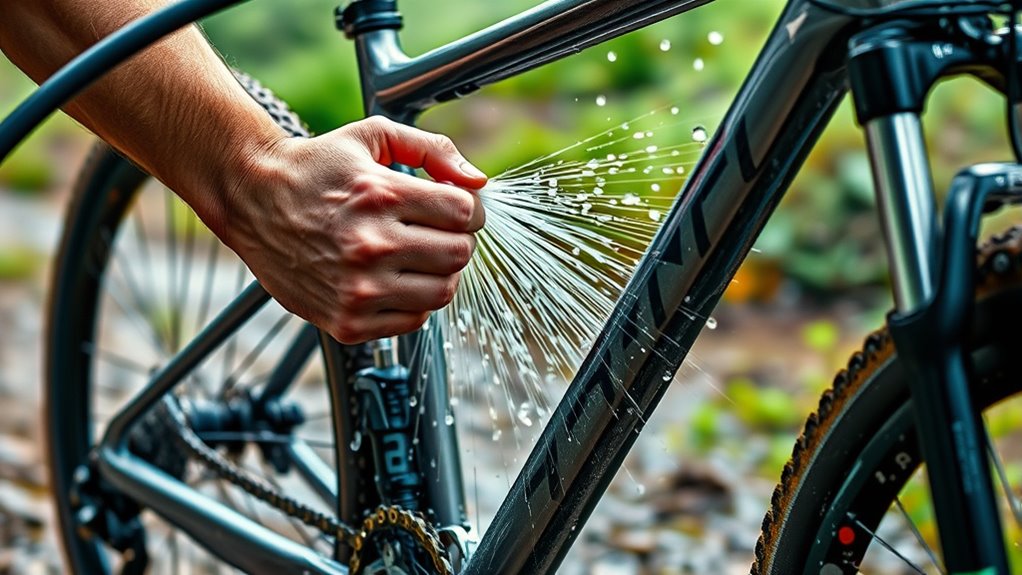
After a rainy ride, it’s important to clean your bike promptly to prevent mud and grime from drying and causing damage. Start by rinsing your bike with a gentle hose or sponge to remove road grime, mud, and grit before they harden. Focus on cleaning your drivetrain, including the chain, cassette, and derailleur, to prevent grit buildup and rust. Use a soft cloth or microfiber towel to wipe down the frame, handlebars, and saddle, absorbing excess water. Pay special attention to drainage areas to prevent water from pooling. If you used wet lube, wipe off any excess to avoid attracting dirt. Cleaning your bike thoroughly now helps maintain smooth operation and protects metal components from corrosion. Regular maintenance also enhances bike longevity and ensures safety during future rides. Incorporating proper cleaning techniques can also prevent long-term damage caused by accumulated dirt and moisture.
Drying and Protecting Your Frame and Components
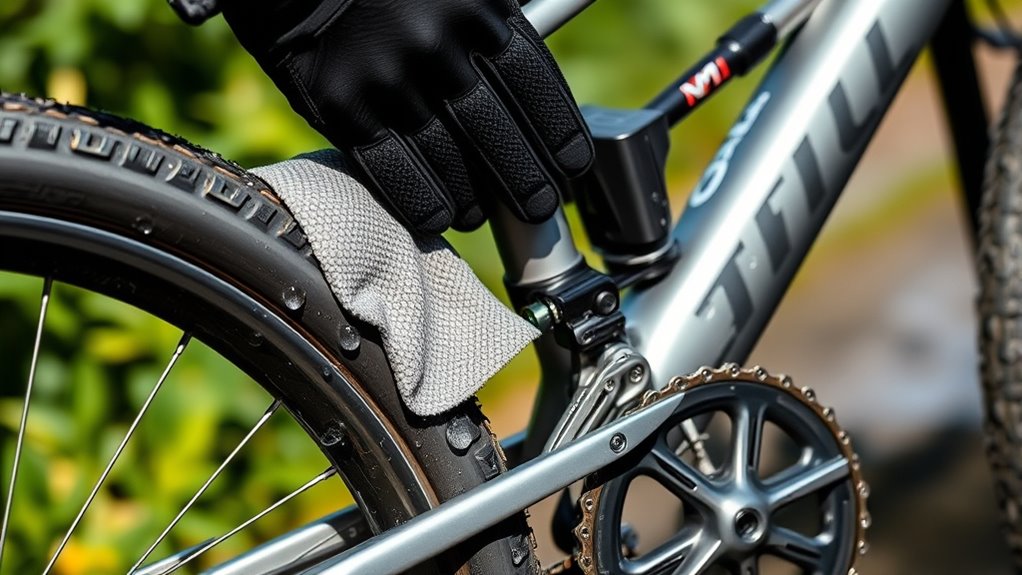
Once you’ve rinsed off the mud and grime, it’s time to thoroughly dry your bike to prevent rust and corrosion. Use towels or rags to dry the frame and components, paying special attention to areas that trap moisture. Removing wheels and wiping down rims, brake surfaces, and spokes helps eliminate residual moisture that could lead to corrosion. To protect your bike further, apply a moisture dispersant or protective polish with PTFE, creating a barrier against water. Visualize your bike with air purification features that keep dust and pollutants at bay, ensuring a cleaner environment for your bike and yourself. Maintaining good indoor air quality can help reduce dust accumulation in your storage area, keeping your bike cleaner longer. Additionally, proper ventilation can help reduce humidity levels in your storage space, further protecting your bike from moisture damage. Incorporating climate control into your storage setup can optimize conditions and extend your bike’s lifespan. Regular maintenance, including lubrication of moving parts, also helps prevent rust and ensures smooth operation. This process ensures your bike stays in top shape, prolongs its lifespan, and maintains its appearance.
Caring for Accessories and Soft Goods

To keep your accessories and soft goods in top condition, it’s essential to dry them thoroughly after a rainy ride. Start by ensuring you dry the bike’s accessories, like Hooptie rails and U-tubes, to prevent corrosion and mold growth. Remove soft goods such as MagicCarpets and air dry them in sunlight or a warm, dry place to extend their lifespan. Avoid using dryers on soft items; instead, let them naturally dry to maintain their integrity. For X3 bags and similar gear, air drying is best to keep them moisture-free and intact. Before storing, double-check that all accessories and soft goods are clean and dry, which helps prevent mildew and damage over time. Proper care guarantees your gear stays functional and in good shape for future rides. Additionally, understanding privacy policies can help you make informed decisions about your data and security while maintaining your gear’s longevity. Regular maintenance and proper drying techniques are essential for preserving the quality of your soft goods and accessories over time. Using appropriate cleaning methods also minimizes the risk of deterioration and keeps your gear looking new longer. Incorporating sound healing science into your routine can also promote overall well-being and recovery, ensuring you stay energized for your next adventure. Remember that store hours for retail locations like Ulta Beauty or Sephora may vary, so planning your visits accordingly can ensure you get the supplies you need for proper cleaning and maintenance.
Maintaining Your Chain and Drivetrain
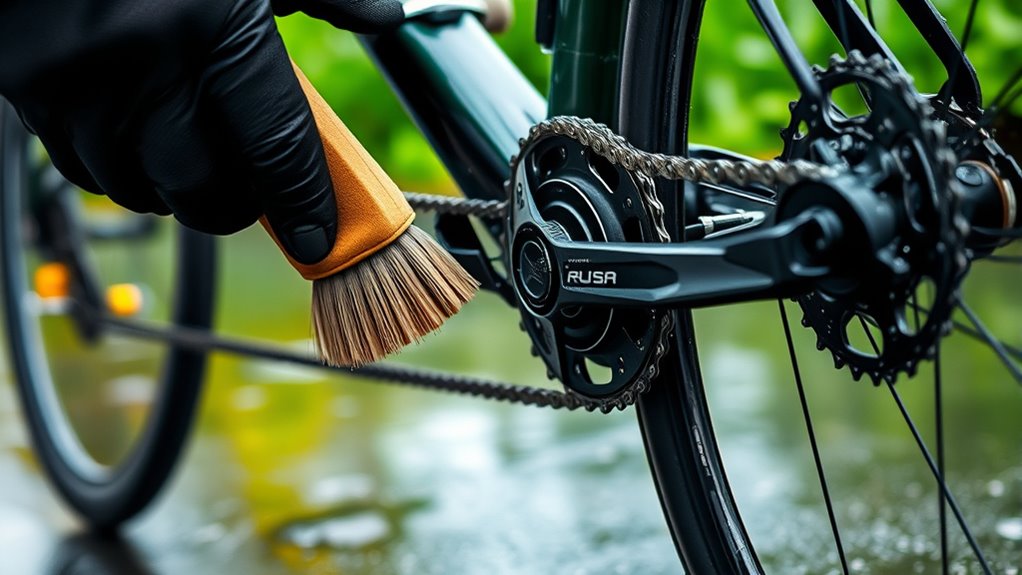
After a rainy ride, it’s vital to remove grit and dirt from your chain and drivetrain to prevent premature wear. Proper lubrication techniques help protect against rust and keep everything running smoothly. Regularly inspecting and maintaining your chain ensures a longer lifespan and peak shifting performance. Incorporating the right paint sprayer accessories strategies can also help you afford quality maintenance products.
Removing Grit and Dirt
Rainy rides leave behind grit and dirt that can quickly wear down your chain and drivetrain components. To prevent this, use a stiff brush and degreaser to scrub away mud, sand, and grime. Focus on:
- Removing stubborn grit from chain links and sprockets
- Rinsing thoroughly with water to wash away residue
- Wiping the chain dry to reduce rust and corrosion
This process helps keep your drivetrain smooth and prolongs its lifespan. After cleaning, don’t forget to apply chain lube to create a protective barrier against dirt and moisture. If you want to keep your bike in top condition, make sure to regularly “clean my bike” after wet rides. Proper removal of grit now saves you from costly repairs and guarantees peak performance on your next ride.
Proper Lubrication Techniques
Proper lubrication is essential for keeping your chain and drivetrain running smoothly, especially after a wet ride. You should lubricate your chain with a thin, even layer of the appropriate lube—wet or dry—after cleaning. Focus on the inside of the chain, derailleur pivots, and cable entry points to ensure smooth shifting. Use a brush or cloth to wipe off any excess lubricant, as too much can attract dirt and grit. Be mindful of excess moisture; reapply chain lubricant after riding in wet conditions to maintain ideal friction and drivetrain efficiency. Proper lubrication also helps prevent corrosion and extends the lifespan of your components by preventing rust. Regular application of the correct type of lubricant can significantly improve your bike’s performance, especially in challenging weather conditions. Using the right maintenance practices can further enhance your bike’s durability and efficiency. Avoid over-lubricating, since excess oil can cause buildup that accelerates wear on your chain and cassette. Proper lubrication helps protect your drivetrain and keeps your bike performing at its best. Additionally, keeping your chain and components clean before lubrication reduces the risk of abrasion and wear, ensuring smoother operation. Regular maintenance also reduces the risk of vulnerabilities to damage, ensuring your bike remains reliable during every ride.
Special Tips for Ebike Batteries and Contacts
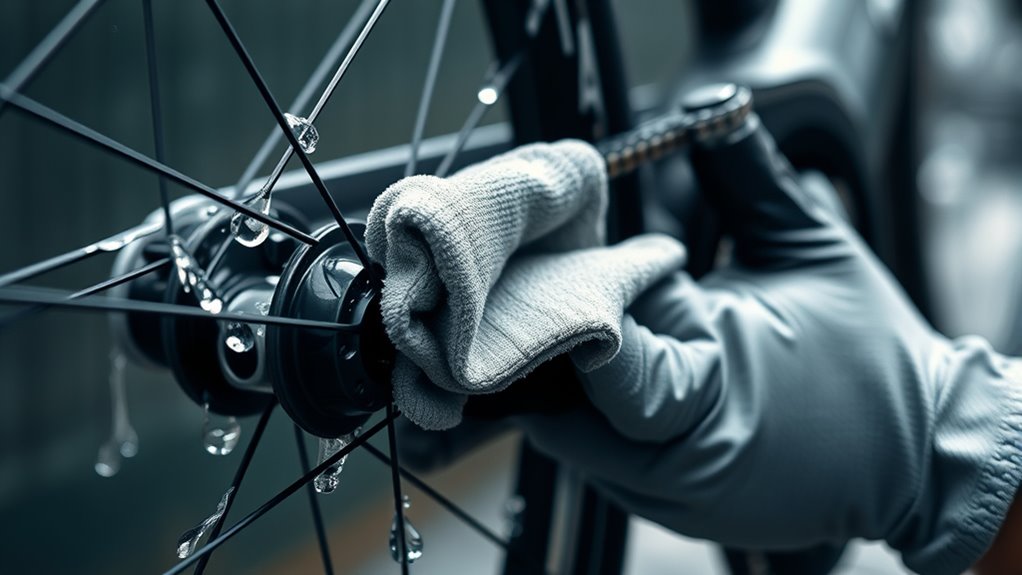
After a rainy ride, make sure to detach your eBike battery to prevent water from pooling on the contacts and mounts. Wipe the contact points and mounting surfaces with a clean cloth and let them air dry in a warm, dry place. Regularly check and clean the terminals to keep your battery connection strong and reliable. Additionally, ensure your bike’s electrical system evaluation is up to date to prevent potential malfunctions caused by moisture exposure.
Battery Contact Care
Even with water-resistant eBike systems, it’s important to keep your battery contacts dry to prevent corrosion and guarantee reliable performance. After a rainy ride, you should carefully inspect and clean the contact points to maintain ideal connections. Use a clean, dry cloth or towel to wipe the battery and mounting area, removing any residual moisture. This prevents water from seeping into sensitive components and causing corrosion. To help visualize, consider these steps:
- Gently wipe the battery contacts with a dry cloth
- Ensure no moisture is trapped around the contact points
- Regularly inspect for signs of corrosion or dirt buildup
Drying and Reattachment
When dealing with wet conditions, always remove your Bosch eBike battery and guarantee both the battery contacts and mount are thoroughly dried before reattaching. Proper drying prevents moisture buildup, which can cause corrosion or electrical faults. Use a clean cloth to dry the contacts and mount completely, ensuring no water remains that could impair connection or system performance. Reattach the battery only once it’s dry to maintain safe, reliable operation. Remember, dry contacts are essential for ideal electrical flow and system longevity. To emphasize, here’s a quick guide:
| Step | Action | Result |
|---|---|---|
| Remove battery | Always detach after riding in rain | Prevents water pooling |
| Dry contacts | Use cloth to dry thoroughly | Ensures proper connection |
| Reattach properly | Ensure contacts are dry before reattaching | Safe, reliable operation |
| Check connection | Confirm battery is firmly mounted | Avoid electrical issues |
Long-Term Care and Storage Practices

Proper long-term care and storage are essential to keep your bike in top condition after a rainy ride. Store your bike indoors in a dry, well-ventilated space to allow moisture to evaporate and prevent rust and corrosion. Remove removable components like saddle posts and accessories to dry thoroughly and avoid moisture buildup. Leave the bike upside down or on a stand overnight so water can drain from bearings and frame cavities. To protect exposed metal parts, apply rust-inhibiting treatments such as Frame Saver or light grease. Regularly inspect your stored bike for signs of corrosion or lingering moisture. Reapply protective coatings as needed to maintain long-term integrity. Keep these practices in mind to ensure your bike stays smooth, rust-free, and ready for your next ride.
Frequently Asked Questions
What to Do After a Rainy Bike Ride?
After a rainy ride, you should start by rinsing your bike with a hose to clear mud and dirt. Wipe down the frame, components, and sensitive parts with a clean rag. Remove the wheels to clean the rims and hubs thoroughly. Dry the entire bike with towels, especially metal parts, to prevent rust. Finally, lubricate the chain and moving parts to keep everything running smoothly.
How to Clean Your Bike After a Muddy Ride?
When you clean your bike after a muddy ride, start by rinsing it with a gentle hose to remove mud and grit, especially on the drivetrain, tires, and frame. Use a soft sponge or brushes with warm, soapy water to scrub stubborn mud, paying attention to hard-to-reach areas. Rinse thoroughly, dry completely, and re-lubricate the chain to keep everything running smoothly and prevent rust.
Can I Wash My Bike After a Ride?
Yes, you can wash your bike after a ride. It’s actually a good idea to do so, especially if it’s muddy or salty. Use a gentle hose or sponge with soapy water, avoiding high-pressure sprayers that could damage parts. Focus on rinsing the drivetrain, brakes, and frame thoroughly. Afterward, dry the bike completely to prevent moisture buildup and corrosion, keeping it in top shape for your next ride.
Do You Need to Dry a Bike After Rain?
Yes, you need to dry your bike after rain. Water left on the frame and components can cause rust and corrosion over time. You should wipe down your bike with a towel or shop rag to remove moisture and help prevent damage. Additionally, letting it air dry in a warm, sunny spot speeds up the process, ensuring your bike stays in good shape and performs well on future rides.
Conclusion
After a rainy ride, cleaning your bike keeps it looking new and running smoothly. You might rush to dry it quickly, but taking time to safeguard every part ensures longevity. The dirt and water vanish, yet your bike’s performance stays. Care now prevents future trouble, while neglect invites corrosion. A clean bike isn’t just shiny; it’s ready for the next adventure, strong and reliable. With each wash, you preserve your ride’s spirit—ready to conquer new trails.



